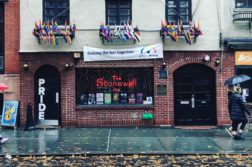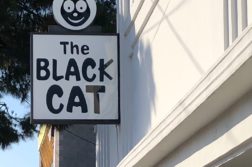This year marks The Gay & Lesbian Review‘s 25th anniversary, and to commemorate this milestone we’ve published In Search of Stonewall, a collection of articles selected from our first 136 issues, since 1994. Starting today and every week in January, we’ll be highlighting sections of the book. Below is the second installment, is Lillian Faderman’s introduction to Part II. “Flashback: The Roots of the Riots.”
THE riots that followed the 1969 raid on the Stonewall Inn in New York and the New York Gay Liberation Front that emerged from those riots were the opening salvos of a militant gay revolution. But as many of the following essays show, the struggle for gay rights had begun two decades earlier. The first gay organizations to last more than a few months, the first gay magazines, and the first gay protests were born on the other side of the continent.
Los Angeles and San Francisco could serve as crucibles for an early movement because even by the mid-20th century those cities hadn’t lost entirely the effects of their “frontier town” histories.1 In the 19th century, L.A. and San Francisco were where refugees from other parts of the United States went to be adventurous, to make their fortunes, to escape the stifling rigidities of “back home.” There, on the edge of the continent, daring experimentation and action could flourish. It’s not surprising, for instance, that in 1911 California became one of the first states to allow women to vote—nearly a decade before the 19th amendment extended the vote to women all over the country. By the mid-20th century, anti-homosexual laws were as draconian in California as they were elsewhere in America, but the spirit that was fostered earlier hadn’t died.
In the years after World War II, the populations of L.A. and San Francisco burgeoned with gay people2 who had been introduced to those port cities while in the military or working in the defense industry. They stayed or returned because they were drawn to the freedom the cities seemed to promise. A subterranean gay life, and soon gay organizations, flourished in both San Francisco and L.A. Dorr Legg and his African-American lover, Marvin Edwards, migrated from Detroit to L.A. in 1949, certain they could live more comfortably there than in the Midwest. A year later, Legg and another African-American man, Merton Bird, founded Knights of the Clock, a small but remarkably forward-thinking society. In an era when interracial couples were rare and taboo almost anywhere in the country—among heterosexuals and homosexuals alike—a primary purpose of Knights of the Clock, as Martha Stone points out in her essay in this section, was to help interracial gay couples find housing and jobs.
Knights of the Clock was not the only gay organization in L.A. at this time. In 1948, Harry Hay read the newly published “Kinsey Report,” which said that ten percent of American men were more-or-less exclusively homosexual, and he dreamed of organizing them. That year he wrote a manifesto in which he compared the murder of homosexuals under the Nazis to the homosexual purges in the State Department, and he drew up plans for a secret organization that would fight homosexual persecution. Two years later, defining homosexuals as “an oppressed cultural minority,” Hay and a handful of other men founded the Mattachine Society. As Hay recalls in his essay “Birth of a Consciousness,” in 1952 Mattachine member Dale Jennings was accused by an L.A. vice squad officer of making homosexual advances. Mattachine waged an unprecedented battle. To raise money and awareness about Jennings’ case, they formed the Citizens Committee to Outlaw Entrapment. And they challenged the testimony of the police in court. Mattachine’s legal victory astonished even gay people, who were not used to winning against the police. New chapters cropped up in San Francisco, New York, Chicago, and Washington, D.C.
The country’s first lesbian organization, Daughters of Bilitis (DOB), was also born on the Left Coast. As Del Martin and Phyllis Lyon recount in “Lesbian Liberation Begins,” their organization, which started in San Francisco in 1955, was founded as a safe alternative to lesbian bars, where raids were always a threat. Though DOB’s social function remained its primary appeal for many members, the organization’s leaders nudged them toward political action. For instance, Del Martin declared in the December 1956 issue of The Ladder, DOB’s new, nationally circulated magazine, that homosexuals “are citizens of the United States, and as such are entitled to those civil rights set forth in the Constitution,” and she suggested as early as 1960 that a unified homosexual vote could influence elections. “We do have a voice in the affairs of the community and the nation,” she exhorted DOB members in The Ladder. “Let’s make it a strong one.”
The same year that The Ladder began publishing, Mattachine headquarters moved to San Francisco and also started a nationally circulated magazine, Mattachine Review, which served a vital purpose in disseminating information that most gay people could find nowhere else. Its first issue, for instance, included an account by UCLA psychologist Dr. Evelyn Hooker about her L.A.-based study which demonstrated that, on major psychological tests such as the Rorschach, healthy male homosexuals could not be distinguished from healthy male heterosexuals. Therefore, “homosexuality” could not legitimately be considered a diagnostic category. (Two decades later her study would help convince the American Psychiatric Association to declassify “homosexuality” from its Diagnostic and Statistical Manual of Mental Disorders).3
But The Ladder and Mattachine Review were not the first gay or lesbian publications in America. The first was a low-circulation lesbian magazine, Vice Versa, published in L.A. from June 1947 to February 1948, which featured vehement proclamations such as (in the September 1947 issue) “The Third Sex is here to stay!” and fierce excoriations (in June 1947) of “self-styled judges who smugly carve the standards for society.” The second gay publication in America, ONE, was started by members of Los Angeles Mattachine in 1952. Two years later, when the office of the L.A. postmaster declared that ONE magazine could not be mailed because it contained material that was “obscene, lewd, lascivious, and filthy,” ONE hired a lawyer who took the case all the way to the U.S. Supreme Court. In 1958, the Court concluded that ONE was indeed a homosexual magazine as the postmaster had complained, but that did not mean the publication was obscene. The Post Office had no right to confiscate ONE, the Supreme Court declared. This was the first national gay victory in U.S. history.
As forward-looking as those mid-20th-century periodicals were, their readership was minuscule compared to that of The Advocate, which started in L.A. as a newsletter after a brutal raid on January 1, 1967, of an L.A. gay bar, the Black Cat, discussed in this section by Eve Goldberg. The Advocate, which became a newspaper and then a magazine, moved to the San Francisco Bay Area in 1974 and later returned to L.A. (Its present circulation of 175,000 makes it America’s most-read LGBT magazine.)
California also saw some of the first gay protests in America. John Rechy remembers in “Lawrence Brought It All Back Home” that more than a decade before Stonewall, he was in a gay mini-riot against harassing police in downtown L.A. San Francisco saw another mini-riot in 1966, when about fifty black and Latino “queens” fought police harassment in their favorite hangout, Compton’s Cafeteria.4 Californians also made their anger over anti-gay injustices felt in ways short of rioting. In 1951, when authorities tried to suspend the liquor license of San Francisco’s Black Cat Café because it catered to homosexuals, its owner, Sol Stoumen, took the case to the California Supreme Court. The Court restored Stoumen’s liquor license, finding that even homosexuals had the right to free association.5 The 1967 raid on L.A.’s Black Cat was answered by a peaceful public protest that drew 500 demonstrators. The following year saw a dramatic “flower power” protest by gays wielding armfuls of bouquets and occupying the Harbor Division Police Station after a raid on The Patch, a Southern California gay bar. “We’re Americans, too!” the protestors had screamed at the raiding police.6 By spring 1969, some gay activists in California were eschewing flower power in favor of images influenced by Black Power. For instance, with more than a passing nod to the Black Panthers, a gay group that staged angry pickets of anti-gay businesses in San Francisco and L.A. dubbed itself “the Pink Panthers.”7
Lesbians and gays on the Left Coast were not the only ones, of course, to protest and agitate for change in the years before Stonewall. John D’Emilio points out in “Frank Kameny Takes It Public” that Kameny, in Washington, D.C., pressed the movement in a more militant and assertive direction than it had ever had, beginning with the 1965 picketing he led in front of the White House, the State Department, and the Pentagon.
But courageous as all these protests of the 1950s and ’60s were, none was “the hairpin drop heard round the world,” as New York Mattachine president Dick Leitsch immediately recognized the Stonewall Riots to be in the July 1969 issue of his organization’s newsletter. What accounts for the spontaneous explosion of Stonewall was less the preceding twenty years of gay organizing and protest than the widespread militancy and turbulence that characterized the 1960s in big cities throughout America: from the Black Power movement, to the long succession of summertime Black riots, to the huge antiwar movement with its sometimes violent demonstrations, to the riots at the 1968 Democratic Convention in Chicago. In the hot summer of the following year, all of that together led to Stonewall.
October 2018
Footnotes
1. The effects of San Francisco’s and Los Angeles’ frontier histories on later gay communities are discussed in Nan Alamilla Boyd’s Wide-Open Town: A History of Queer San Francisco to 1965 (University of California Press, 2003); and Lillian Faderman and Stuart Timmons in Gay L.A.: A History of Sexual Outlaws, Power Politics, and Lipstick Lesbians (Basic Books, 2006).
2. In the mid-20th century “gay” was an umbrella term that described people who would be called “LGBT” in the 21st century.
3. I discuss Evelyn Hooker’s study and the APA’s declassification of homosexuality in The Gay Revolution: The Story of the Struggle (Simon and Schuster, 2015).
4. Screaming Queens: The Riot at Compton’s Cafeteria, a documentary by Susan Stryker and Victor Silverman, 2005.
5. Sol Stoumen v. George R. Reilly, 37 Cal., 2d 713, S.F. no. 18310, August 28, 1951.
6. “Patch Fights Three-Way Battle,” Los Angeles Advocate, August 1968; and Dick Michaels, “Patch Raids Police Station,” Los Angeles Advocate, September 1968.
7. “Homo Revolt Blasting Off on Two Fronts,” Berkeley Barb, April 11-17, 1969; Leo E. Laurence, “Gay Revolution,” Vector, April 1969; and Leo E. Laurence, “Gay Strike Hits Southern California, Berkeley Barb, May 2-8, 1970.
 Lillian Faderman, author of Surpassing the Love of Men: Romantic Friendship and Love Between Women from the Renaissance to the Present (1981), Odd Girls and Twilight Lovers: A History of Lesbian Life in Twentieth-Century America (1991), and The Gay Revolution: The Story of the Struggle (2015), taught history at California State–Fresno until 2007.
Lillian Faderman, author of Surpassing the Love of Men: Romantic Friendship and Love Between Women from the Renaissance to the Present (1981), Odd Girls and Twilight Lovers: A History of Lesbian Life in Twentieth-Century America (1991), and The Gay Revolution: The Story of the Struggle (2015), taught history at California State–Fresno until 2007.




